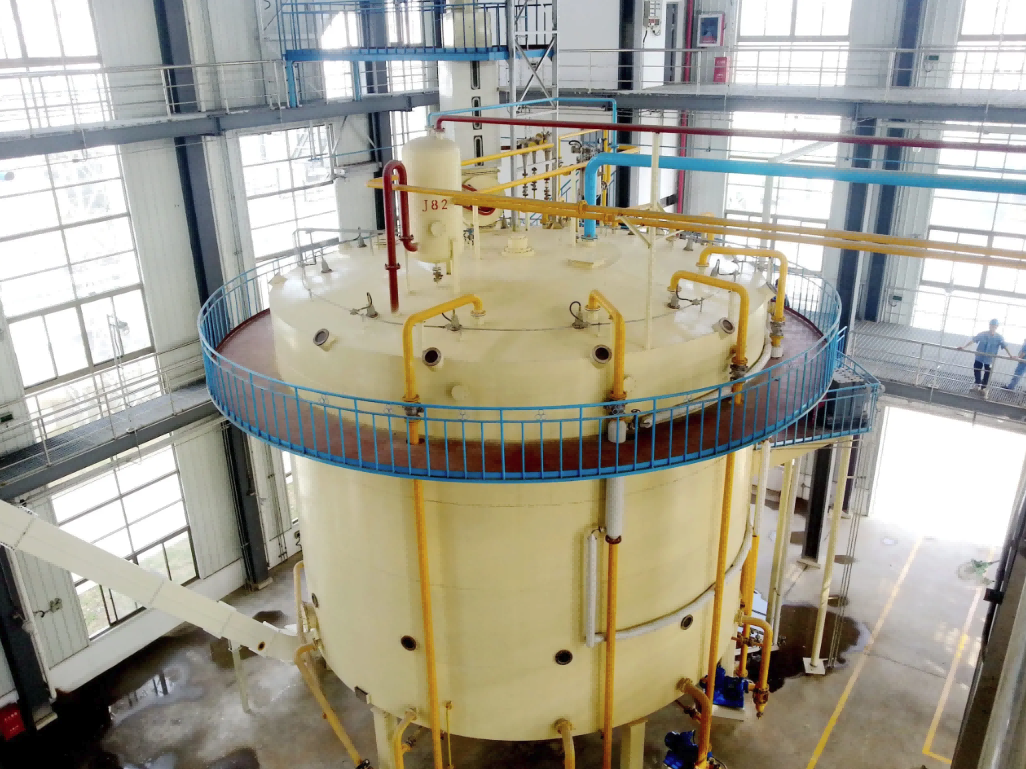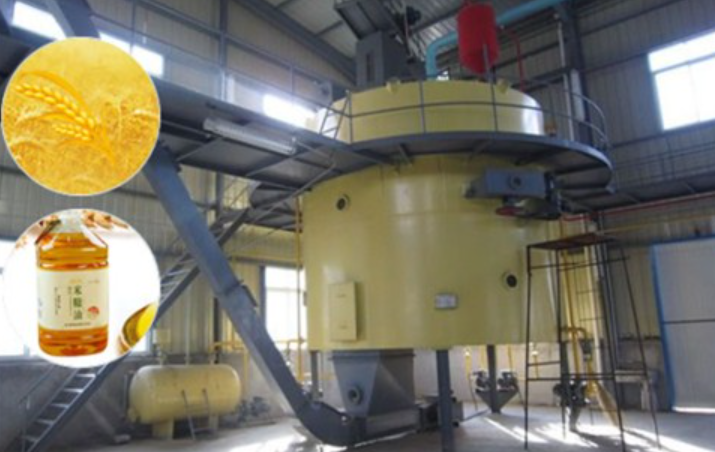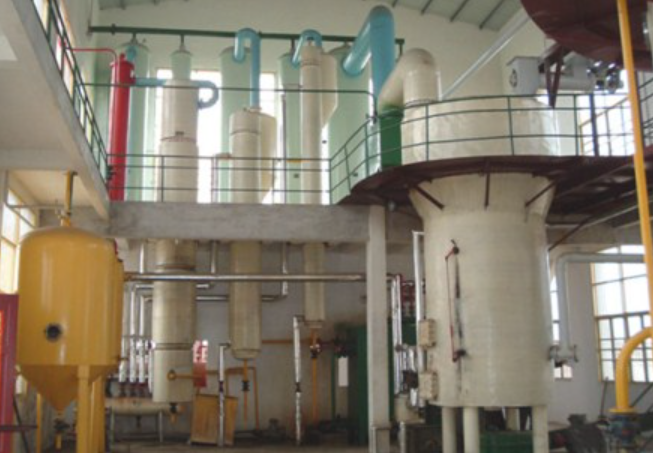Grease leaching is the application of the principle of extraction, which is the process of using organic solvents to extract the oil from the oil. Generally, n-hexane is used to spray and soak the oil, so that the oil in the oil is extracted, and the mixed oil and solid residue (wet meal) are obtained. The mixed oil is evaporated and stripped at different boiling points, so that the solvent is vaporized into vapor and separated from the oil to obtain grease (extracted crude oil). The solvent vapor is condensed, cooled and recovered, and then recycled. The wet meal also contains the required amount of solvent, and the dry meal is obtained after desolventizing and drying. The solvent vapor volatilized during desolventizing and drying is still condensed and cooled for recycling.
Generally, oils with high oil content such as peanuts still contain a large amount of oil in the peanut cake obtained in the pretreatment and pressing section. After the leaching section, the oil content in the cake can be less than 1%. Oils with low oil content such as soybeans can be directly fed into the leaching section after pretreatment, and the oil yield will be accelerated.

The grease leaching section includes four processes, namely: grease leaching, wet meal desolventization and drying, evaporation of mixed oil, and condensation and recovery of vapor and solvent vapor.
1. Grease leaching
(1) Process flow: raw material (or pre-pressed cake) → storage box → closed auger → (solvent →) extractor (→ wet meal) → mixed oil
The raw material or pre-pressed cake formed by the pretreatment of the oil is sent to the extractor by the conveying equipment, and the concentrated mixed oil and wet meal are obtained after solvent leaching.
(2) Extraction equipment: The important equipment of the extraction system is the extractor, which has many forms.
Intermittent leaching device-leaching tank; continuous leaching device-flat-rotating leaching device, annular leaching device, drag chain box leaching device, etc.

2. Desolventizing and drying of wet meal
(1) Process flow: wet meal → scraper conveyor → steaming off machine (mixed steam) → dry meal (cooling) → warehouse;
→Solvent vapor→condensation and recovery;
The meal discharged from the extractor contains 25%-35% solvent. In order to recover these solvents and obtain better quality meal, steam heating can be used to evaporate and remove the solvent. The obtained finished meal is sent to the warehouse, and the obtained solvent vapor enters the condensation recovery system.
(2) Desolventizing and drying equipment The desolventizing and drying of the leached meal from the pre-pressed cake mostly adopts high-layer steaming and desolving machine, and for the desolventizing and drying of the soybean dregs once, the D.T steaming and desorbing machine should be adopted.
3. Evaporation and stripping of mixed oil
(1) Process: mixed oil filtration → mixed oil storage tank → d evaporator → second evaporator → stripper → leaching crude oil;
The mixed oil (a solution composed of grease and solvent) pumped from the extractor must be treated to separate the grease from the solvent. The separation method is to "pre-treat" the mixed oil to remove the solid dregs and colloidal substances, and then use the different boiling points of the oil and the solvent to initially heat the mixed oil to vaporize most of the solvent and combine with the oil. Separate. Then, using the difference between the volatility of the grease and the solvent, the concentrated mixed oil is steam distilled (that is, steam stripping) to distill out the residual solvent in the crude oil, so as to obtain the leached crude oil with very low solvent content.
(2) Evaporation equipment of mixed oil-long tube evaporator
The evaporation of the mixed oil is a process in which the oil is almost non-volatile, and the solvent has a low boiling point and is easy to volatilize. Heating is used to vaporize most of the solvent, thereby greatly accelerating the concentration of the oil in the mixed oil. In the selection of evaporation equipment, oil plants often use long tube evaporators (also called "rising film evaporators"). Its characteristic is that the heating pipe is long, the mixed oil enters the heating pipe from the lower part after being preheated, and boils quickly, producing a large amount of vapor bubbles and rising rapidly. The mixed oil is also driven by the rising vapor bubbles and drawn as a liquid film that rises along the pipe wall, and the solvent continues to evaporate in the process. Since heat is transferred in a thin film state, the evaporation efficiency is higher.
(3) Stripping equipment for mixed oil-stripping tower
Through evaporation, the concentration of the mixed oil is greatly accelerated. However, the boiling point of the solvent also increases. Regardless of whether the normal pressure evaporation is continued or the reduced pressure evaporation is changed, it is quite difficult to basically remove the remaining solvent in the mixed oil. Only by steam stripping can the residual solvent in the mixed oil be basically removed.

4. Process flow of solvent vapor condensation and cooling
Since the solvent vapor from the second evaporator does not contain water, it flows directly into the circulating solvent tank after being cooled by the cold exchanger; the mixed vapor from the stripper and steamer enters the condenser, and the condensed solvent and water are mixed The liquid flows into the water separator for water separation, the separated solvent flows into the circulating solvent tank, and the water enters the water-sealed tank, and then is discharged into the sewer.
If the water discharged from the water separator contains solvent, it will enter the cooking tank, after the trace solvent in the water is evaporated, the condensate will enter the water separator through the condenser, and the waste water will enter the water sealing tank.
Under normal circumstances, the wastewater discharged from the water separator is treated by a water-sealed tank, but when there is a large amount of dregs in the water, a part of the wastewater in an emulsified state should be sent to the wastewater digestion tank and heated to above 92°C with steam. But no more than 98°C, the solvent contained in it will evaporate, and then it will be recovered by the condenser.
Copyright © Henan Zhongxing Grain And Oil Machinery Co.,Ltd. All Rights Reserved. Powered by MetInfo